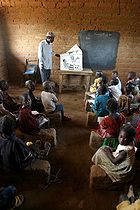
Education in the Central African Republic
Encyclopedia

Central African Republic
The Central African Republic , is a landlocked country in Central Africa. It borders Chad in the north, Sudan in the north east, South Sudan in the east, the Democratic Republic of the Congo and the Republic of the Congo in the south, and Cameroon in the west. The CAR covers a land area of about ,...
is free, and education is compulsory from ages 6 to 14. AIDS-related deaths have taken a heavy toll on teachers, contributing to the closure of more than 100 primary schools between 1996 and 1998. In 1991, the gross primary enrollment rate was 56.9 percent. In 2000, the net primary enrollment rate for children between the ages of 6 and 11 was 43 percent. Primary school attendance rates were unavailable for the Central African Republic as of 2001. While enrollment rates indicate a level of commitment to education, they do not always reflect children’s participation in school. The educational system’s meager budget and salary arrears have resulted in a shortage of teachers and an increase in the number of street children. The percentage of the national budget allocated to education, which traditionally stood at less than 12 percent, increased to 18 percent in the late 1990s. According to the government, it will further increase to 25 percent by 2010.

